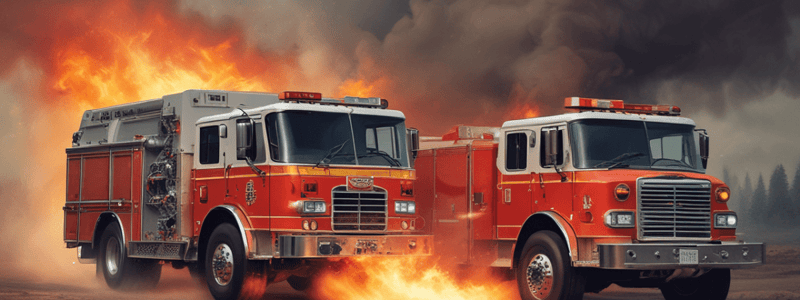Podcast
Questions and Answers
What is the primary goal of understanding fire dynamics?
What is the primary goal of understanding fire dynamics?
- To gain knowledge on how to extinguish fire
- To increase the effectiveness and safety of firefighters on the fireground (correct)
- To learn about the different firefighting practices
- To study the evolution of firefighting equipment
What is the definition of heat energy according to NFPA 921?
What is the definition of heat energy according to NFPA 921?
- The rate at which fire releases energy
- A measure of the degree of molecular activity of a material
- A form of energy characterized by vibration of molecules (correct)
- A rapid oxidation process
What is the main reason for Fire Dynamics to be studied by firefighters?
What is the main reason for Fire Dynamics to be studied by firefighters?
- To learn about building construction materials
- To improve their physical fitness
- To familiarize themselves with new firefighting equipment
- To understand how fires start, spread and develop (correct)
What is the unit of measurement for Heat Release Rate (HRR)?
What is the unit of measurement for Heat Release Rate (HRR)?
What is heat flux?
What is heat flux?
What is the outcome of recognizing potential hazards and catastrophic fire events early?
What is the outcome of recognizing potential hazards and catastrophic fire events early?
What is conduction in the context of heat transfer?
What is conduction in the context of heat transfer?
According to Guidance Note #6-6, what should fire departments develop for suppression personnel?
According to Guidance Note #6-6, what should fire departments develop for suppression personnel?
What is the result of modern construction materials and methods in fires?
What is the result of modern construction materials and methods in fires?
What are the factors that influence fire development?
What are the factors that influence fire development?
Why is it necessary to study Fire Dynamics?
Why is it necessary to study Fire Dynamics?
What is the benefit of understanding fire behavior for arriving crews?
What is the benefit of understanding fire behavior for arriving crews?
Study Notes
Fire Fighters Guidance Note
- Fire departments should develop training in fire dynamics for suppression personnel to understand compartment fire behavior and rapid fire progression events. (Guidance Note #6-6).
History of Firefighting
- Firefighting has been a process of trial and error for over 200 years, with varying results.
- Upgrades in firefighting equipment and changes in building construction have made it necessary to study the science of fire.
Fire Dynamics
- Fire dynamics is the study of how fires start, spread, and develop.
- Understanding fire dynamics assists operations firefighters in developing strategies and tactics when responding to a fire incident.
Importance of Fire Dynamics
- Knowledge of fire behavior helps firefighters understand potential hazards and catastrophic fire events.
- Recognizing these events early aids in mitigating contributing factors and deciding to continue with a tactic or retreat.
Modern Construction Materials
- Modern construction materials and methods contribute to fires of higher energy and greater potential for structural compromise.
- Knowing the building profile and fire progression helps arriving crews develop a strategy or tactic.
UL/NIST Studies
- Studies from UL/NIST applied various firefighting practices in acquired structures to determine measurable results.
- These results, combined with fire dynamics, have greatly improved understanding of fire progression and behavior.
Firefighter Safety
- Firefighters armed with a basic knowledge of fire dynamics will be more effective and safer on the fireground.
Fire Dynamics Definitions
- Fire: a rapid oxidation process, resulting in the evolution of light and heat in varying intensities.
- Heat Energy: a form of energy characterized by vibration of molecules, capable of initiating and supporting chemical changes and changes of state.
- Temperature: a measure of the degree of molecular activity of a material compared to a reference point.
- Heat Release Rate (HRR): the rate at which fire releases energy, measured in Watts (W), Kilowatts (kW), or Megawatts (MW).
- Heat Flux: the rate of heat energy transferred per surface unit area, measured in kW/m2.
- Heat Transfer: a major factor in the ignition, growth, spread, decay, and extinction of a fire, always transferred from hotter to cooler objects.
Heat Flux Examples
- Sunny day: 2.5 kW/m2
- Typical firefighter exposure: 3-5 kW/m2
- Pain to skin within seconds: 20 kW/m2
- Threshold flux to floor at flashover: 84 kW/m2
- Thermal Protective Performance Test (NFPA 1971): 60-200 kW/m2
Heat Transfer Modes
- Conduction: heat transfer within solids or between contacting solids.
- Convection: heat transfer through natural movement of gases or liquids from higher pressure areas to lower pressure areas (buoyancy).
- Radiation: heat transfer by electromagnetic waves.
Fire Phenomena
- Fire Development: a function of many factors, including fuel properties, fuel quality, ventilation, compartment geometry, location of fire, and ambient conditions.
Studying That Suits You
Use AI to generate personalized quizzes and flashcards to suit your learning preferences.
Description
Learn about the importance of fire dynamics training for fire suppression personnel, including understanding modern contents' combustibility and its impact on compartment fire behavior.




